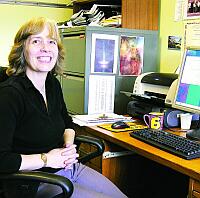
|
Professor Janet Drew
Chair of the
ING Board. [ JPEG | TIFF ]
|
|
It is a pleasure to write this foreword to
the 2002-2003 Biennial Report of the Isaac Newton Group of Telescopes, on
behalf of the ING Board.
In the 2000-2001 Report it was already appropriate to note that times were
both ‘interesting’ and ‘difficult’. This remains the case as the ING continues
to work at the forefront, whilst the staff reorganisation and reduction
envisaged in 2000/2001 has taken effect. Inevitably, it has been sad seeing
staff members, often after many years of highly-valued service, moving on.
But it has been a huge benefit to the Canaries observatories collectively,
and indeed to European astronomy that a way through for the ING in a harsher
financial climate has been found and taken successfully. The Board
has been impressed by the way telescope operations have held together as
a profound change has had to occur. We applaud everyone on the staff who
has made a positive contribution to this tough transition.
So indeed, despite the considerable upheaval of the past two years, excellent
science has continued to flow off the telescopes. The scientific highlights
presented in this new report illustrate very well the enormous breadth of
astronomical problems the William Herschel and Isaac Newton Telescopes are
able to support: everything —from tracking a Near Earth Object supported
by NAOMI adaptive optics, through to measuring cosmic shear in the large-scale
Universe— is here. Recent times have seen quite a volume of traffic
of specialised visitor instruments onto the William Herschel, and so it is
entirely right to find a number of science highlights linked with them. My
own favourite among these has to be the controversial result on the seeming
absence of dark matter from a number of elliptical galaxies. Where would
we be in science if expectations were always met?! More seriously though,
the fact of the several visitor instruments, together with continuing impressive
in-house instrumentation developments attest to a continuing and essential
dynamism at the ING.
An important moment in the last year was the formal signing of the new
agreement between PPARC, NWO and the IAC that sets out the funding framework
up until 2009. The new, formal involvement of the IAC in the expanded three-way
partnership has already become real through the in-kind and much-needed
contribution of new staff to the ING. In terms of shaping the future science
direction of the ING, a very important recent event has been the NWO decision
to release enough funds to give the go-ahead to the build of a fast-track
Rayleigh Laser Guide Star system (RLGS) for the William Herschel. The Board
sees this as bringing the long-running adaptive optics development at the
ING to proper fruition, and it looks forward to the benefit this capability
will bestow on the partner astronomy communities —the nearly all-sky access
the RLGS will offer AO-assisted astronomy will transform it from niche to
mainstream. All being well, the RLGS could come into being by spring 2006.
As part of the reorganisation of the ING, it has been necessary in 2003 to
bring observing with the Jacobus Kapteyn Telescope to an end. But in the
belief that good telescopes never ‘die’, the Board hopes to soon be reviewing
bids from interested parties that will give the JKT a new and different
lease of life.
It only remains to invite you the reader to discover for yourself in this
Biennial Report how the ING has continued to play its important role in
world astronomy. And on behalf of the Board I would like to take this opportunity
to re-affirm our commitment to working with the ING Director and senior
management team into the ever-changing future. It is a privilege, as well
as a challenge.
|

